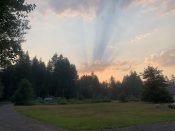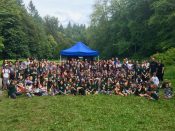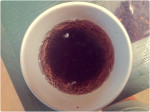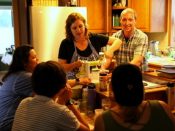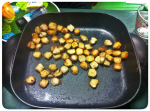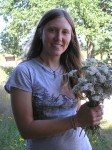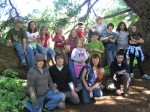Who doesn’t enjoy a refreshing, sparkling soda?
We’ve noticed that lately, more and more independent artisan sodas are appearing in our local grocery store. Most of them use organic (or even local!) ingredients, cane sugar or stevia, fermented starters, or even herbal extracts. This is awesome! We can join in the artisan/homebrew movement and easily make our own natural herbal sodas at home, using just a homemade herbal syrup, sparkling water, and some ice.

At Wolf College’s Herbal camps, we like to teach how to make herbal syrups. Syrups are a favored way to make herbal remedies, since they are easy to use, convenient, and flavorful. A syrup is also a great way to get kids involved in herbalism, since they can help out during the whole process and enjoy the finished product.
Elderberry syrup is one of my favorite herbal remedies, since it can be used as an immune booster, cold/flu fighter, and it tastes great.
→ Click on over to Rain Mountain Crafts to read Hannah’s guide for Elderberry Syrup as a cold & flu natural remedy —Click and take me there!→
I love the rich berry flavor of Elderberry syrup, and its health benefits are hard to beat. For a lighter flavor, we can also make a syrup from Elderflowers. The delicate floral essence of Elderflower syrup is perfect for hot summer days — it has a light flavor and a hint of sweetness that will keep you cool and refreshed.
So, here’s our Elder Herbal soda recipe, complete with two syrup recipes from the amazing Elderberry plant. Try one or both, and let us know how it goes!
**Note: the green fruits, stems, bark, leaves, and roots of Elderberry contain a cyanide-producing glycoside and are classified as toxic. So, avoid these parts of the plants. Flowers are safe to use and the berries should be cooked or dried before consuming.
Ingredients for Elder Herbal Soda:
2-4 ounces Elderberry or Elderflower Syrup **recipes for both included
1 cup sparkling water (plain)
Lots of ice
* Both dried Elderberries and Elderflowers can be purchased from Mountain Rose Herbs or you can responsibly wildcraft your own!
Directions for Elder Herbal Soda:
In a large carafe, combine syrup and sparkling water — I wouldn’t recommend using both syrups at the same time, since they both have distinct flavors.
Mix well and serve over ice. Enjoy!
Ingredients for Elderberry Syrup:
1 cup fresh OR 1/2 cup dried Elderberries (Sambucus nigra)
2 cups water
1/2 – 2 cups raw Honey or choice of sweetener — this acts as a preserver as well as a sweetener

Directions for Elderberry Syrup:
Place water and elderberries into a pan and bring to a boil. Cover and reduce heat to a simmer, until liquid has reduced by about half. We used a popsicle stick to take the original height of liquid to compare (very scientific!).
When reduced, remove from heat and let cool until cool enough to handle. Strain the liquid through a sieve, discarding the berries. We mashed the berries in the sieve to try to extract as much liquid as possible.
Once the liquid is no longer hot, add in the sweetener. Stir thoroughly.
Label your syrup with the name and date, and store in the fridge.

Ingredients for Elderflower Syrup:
~ 20 de-stemmed Elder flower heads, harvested in a cloth/paper bag (not plastic) and away from roads or other potential sources of pollution
35 oz of Sugar (about 5 cups)
1 tsp of Citric Acid (natural preservative)
1 Organic lemon
Water
Directions for Elderflower syrup:
It is very important to de-stem the elderflowers!
De-stem and gently rinse the Elderflowers, making sure all bugs and other debris are removed.
Once the Elderflowers are de-stemmed, place the flowers into a large stainless-steel bowl. You will need at least 2 cups of blossoms. Set aside for now.
Place 35 oz of sugar and 5 cups of water into a large pot. Add in the teaspoon of citric acid and stir well. Bring the mixture to a boil over medium heat and cook until the sugar has dissolved.
While the mixture is dissolving (keep an eye on it) wash the lemon and zest it. Try not to grate the pith as this will give the syrup a very bitter taste. After the lemon is zested, slice the remainder into thin circular pieces. Add the zest and the lemon slices to the Elder blossoms.
Once the sugar is dissolved all the way, boil the syrup mixture for an additional 5 minutes.
Next, pour the hot sugar mixture into the Elder blossom bowl. Gently stir to combine the mixture, making sure that the sugar hasn’t fallen to the bottom.
Cover the bowl with a towel and store in a cool place for 3-4 days, stirring at least once a day. This will allow the Elderflowers to infuse the syrup. Do not store for more than 4 days, as the flowers will begin to ferment.
After 3-4 days, we can now bottle the syrup. Get out a fine mesh sieve, a cheesecloth, or a jelly strainer bag, and several glass bottles to decant the syrup into.
You will now need to sterilize the bottles in the oven. On a low heat, place the bottles into the oven (no hotter than 300°F) — if the oven is too hot, the glass will crack. Let them sit for 10-15 minutes to sterilize.
Now, strain the blossoms from the syrup — the syrup should now be clean and golden.
In a clean pot, bring the syrup to a boil.
Next, pour the syrup into the bottles and carefully close the jars — they will be very hot!
Don’t forget to label with name, date, and ingredients. They can be stored in a cool and dry place for about a year. However, once opened, they need to be stored in the fridge.

Learn how to confidently identify plants using their unique family patterns in this in-depth video by author of Botany in a Day, Thomas Elpel!
*** For educational purposes only. This information has not been evaluated by the Food and Drug Administration. This information is not intended to diagnose, treat, cure or prevent any disease. We recommend that you consult with a qualified health care practitioner before using herbal products, particularly if you are pregnant, nursing or on any medications. ***
*** Please read our Honorable Harvesting Guidelines before harvesting any plant material. The final guideline is of utmost importance: “Never put anything in your mouth unless you are 100% sure it is safe to ingest.” ***
 Hannah began her apprenticeship at Wolf Camp in 2013 and graduated as a lead herbal instructor in 2014. Join Hannah and other Wolf College wild chefs during our annual Wild Cooking & Ethnobotany Expedition: The Herbal Foray the second week of July on Lake Sammamish near Seattle.
Hannah began her apprenticeship at Wolf Camp in 2013 and graduated as a lead herbal instructor in 2014. Join Hannah and other Wolf College wild chefs during our annual Wild Cooking & Ethnobotany Expedition: The Herbal Foray the second week of July on Lake Sammamish near Seattle.
Hannah graduated from the University of Oregon in 2014 with a Bachelor’s Degree in Foreign Languages. She has her own blog, where she writes about her love for crafts, animals, plants, cooking, and the outdoors: rainmountaincrafts.com


